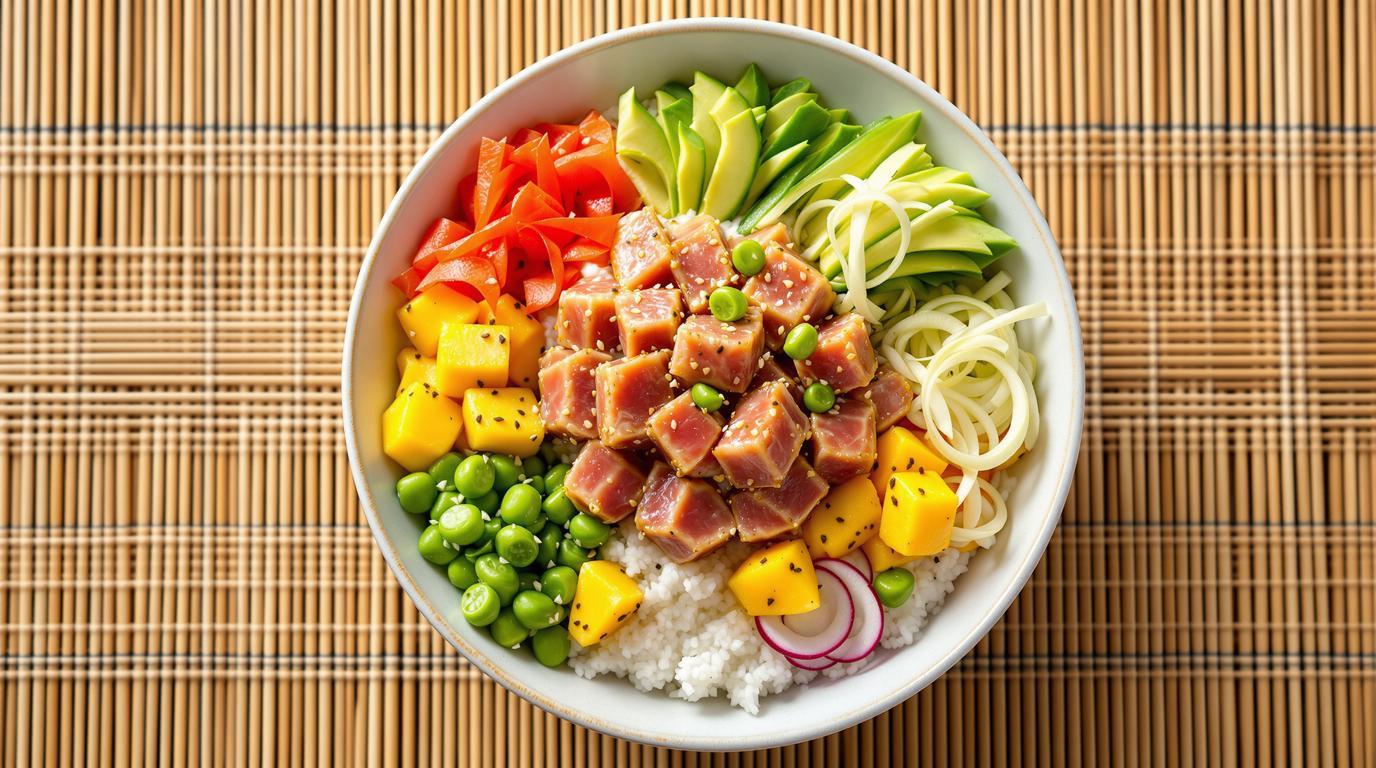I still remember the first time I encountered a traditional Hawaiian poke bowl. Standing in a tiny beachside shack on Oahu’s North Shore, watching a weathered fisherman’s hands deftly cube fresh ahi tuna caught just hours before. There’s something magical about this dish that captures Hawaii’s essence – vibrant colors, fresh ocean flavors, and multicultural influences that span generations. The beauty of poke (pronounced poh-kay, meaning “to slice” in Hawaiian) lies in its simplicity, yet the explosion of flavors and textures creates something truly extraordinary.
The Soul of Hawaiian Poke 🏝️
Traditional poke has existed in Hawaii for centuries, originally created by native fishermen who would season their fresh catch with sea salt, limu (seaweed), and crushed kukui nuts. What we now recognize as the modern poke bowl evolved in the 1970s when Japanese culinary influences brought soy sauce, sesame oil, and rice into the equation. The version I’m sharing today honors these traditions while creating a visually stunning rainbow of ingredients that will transport your taste buds straight to the islands.
Essential Ingredients: Quality Matters 🐟
For the base:
- 2 cups sushi rice (short-grain Japanese rice) or Calrose rice
- 2¼ cups water
- 2 tablespoons rice vinegar
- 1 tablespoon sugar
- ½ teaspoon salt
For the poke:
- 1 pound sashimi-grade ahi tuna (substitute: salmon for a milder flavor)
- ¼ cup soy sauce (shoyu)
- 2 tablespoons sesame oil
- 1 tablespoon rice vinegar
- ½ small sweet onion, thinly sliced
- 2 stalks green onion, thinly sliced
- 1 teaspoon grated fresh ginger
- ½ teaspoon red pepper flakes (optional)
For the colorful assembly:
- 1 ripe avocado, sliced
- 1 ripe mango, cubed
- 1 cup edamame, shelled and cooked
- 4-5 radishes, thinly sliced
- 1 cucumber, thinly sliced
- 1 tablespoon black and white sesame seeds
- 1 sheet nori, cut into thin strips (optional)
Step-by-Step Preparation 🔪
For perfect sushi rice:
- Rinse the rice thoroughly until water runs clear – I typically rinse 4-5 times, which removes excess starch and prevents gummy rice.
- Combine rinsed rice and water in a heavy-bottomed pot. Bring to a boil, then reduce heat to low, cover, and simmer for 15 minutes.
- Remove from heat and let stand, covered, for 10 minutes – resist the urge to peek!
- Meanwhile, mix rice vinegar, sugar, and salt in a small bowl until dissolved.
- Transfer rice to a wide, non-metallic bowl and gently fold in the vinegar mixture using a cutting motion while fanning the rice to cool it quickly. This creates that distinctive glossy texture.
For the poke marinade:
- Cut tuna into ¾-inch cubes. When cutting fish for poke, I always use my sharpest knife and aim for uniform pieces for even flavor distribution.
- In a glass bowl, whisk together soy sauce, sesame oil, rice vinegar, and ginger.
- Add tuna, sweet onion, and green onion to the marinade, gently folding to coat each piece.
- Cover and refrigerate for 15-30 minutes – any longer and the acids will begin to “cook” the fish.
Chef’s Note: Temperature is crucial when working with raw fish. Keep your tuna in the refrigerator until just before cutting, and always use a clean cutting board dedicated to seafood. The freshness of your fish is non-negotiable – develop a relationship with a trustworthy fishmonger who can guide you to sashimi-grade options.
Assembly: Creating Your Rainbow 🌈
- Divide the rice among four bowls, creating a base layer.
- Arrange the marinated tuna in the center of each bowl.
- Create a color wheel around the tuna by arranging avocado, mango, edamame, radishes, and cucumber in separate sections.
- Sprinkle with sesame seeds and nori strips if using.
- Serve immediately, encouraging diners to mix everything together before eating.
Flavor Variations & Pairings 🥢
While this recipe embraces traditional Hawaiian flavors, don’t be afraid to experiment. A simple wasabi mayo (just mix 3 tablespoons mayo with 1 teaspoon wasabi paste) adds a creamy heat. For an island-authentic experience, serve with a side of seaweed salad and pickled ginger.
In Hawaii, we’d likely pair this with a cold Longboard Island Lager, but a crisp Sauvignon Blanc or unfiltered sake works beautifully as well, cutting through the richness of the fish and complementing the bright flavors.
What I love most about sharing poke is watching people’s faces light up with that first bite – the perfect harmony of textures and flavors, from the buttery avocado to the sweet mango against the savory umami of the marinated fish. Like most great dishes that stand the test of time, poke connects us to generations of island wisdom, teaching us that the freshest ingredients need only simple preparations to shine. Make this rainbow bowl your own, and you’ll understand why Hawaiians have treasured this dish for centuries.
